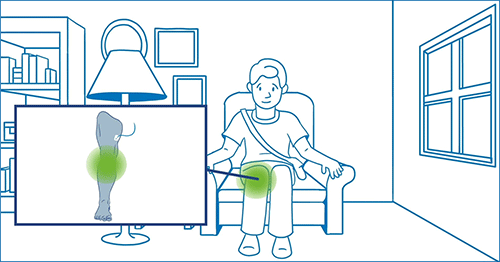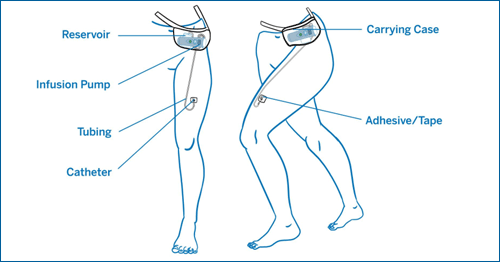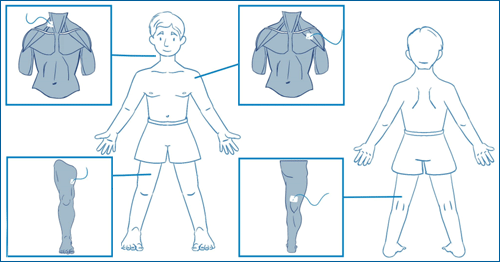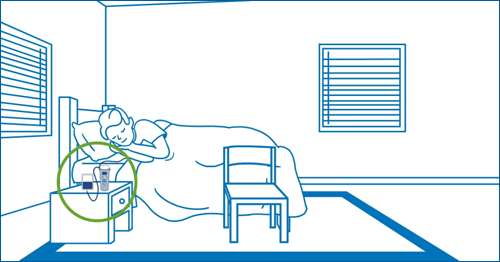Take-Home Nerve Block Catheter: Improving Pain Relief After Surgery

In many patients who undergo orthopedic procedures, the surgeon may recommend they wear a take-home nerve block catheter for a brief time to help manage their postsurgical pain.
These devices can help patients leave the hospital sooner, reduce the need for opioids, and facilitate quicker recovery of movement and function of the part of the body where surgery was performed.
What is a nerve block catheter?
A nerve block catheter, sometimes called a “peripheral nerve block catheter” or a “perineural catheter,” is a safe and effective way of reducing pain after you have had surgery. This wearable catheter is a thin tube that is inserted under your skin after surgery to deliver numbing medicine around your nerves. The medicine generally lasts about two to four days, depending on your type of surgery and the medicine chosen by your anesthesiologist.
How does a nerve block catheter work?

The catheter is connected to tubing that is attached to an infusion pump and a reservoir of non-opioid pain medication. The catheter is held in place with adhesive and tape. Before you leave the hospital, you will be given a small carrying case to transport the infusion pump as you move around.
The infusion pump will deliver medicine automatically. You do not have to do anything to manage the amount of medicine you’re receiving, unless directed by your medical care team.
You may be given an option to press a button to give an additional dose of pain medicine, called a “bolus.” After a bolus, the button will lock for a period of time to prevent you from receiving too much medicine at once. When the button unlocks, you will be able to give another bolus if needed. Do not let anyone press the bolus button without your consent.
Where is a nerve block catheter located on the body?
Catheters can be placed in several locations to target different nerves in the body. They can be placed in the neck for shoulder surgery, below the collar bone for arm surgery, in the thigh for knee surgery, or behind the knee for foot or ankle surgery. HSS places nerve block catheters in the thigh for certain patients and procedures, such as knee replacement.

Who is a good candidate to receive a take-home nerve block catheter?
Your surgeon will determine if you are a good candidate to receive a take-home nerve block catheter based on a variety of factors, including your type of surgery and whether you have support at home to manage your care.
What kind of pain medicine is used in the nerve block catheter?
Take-home nerve block catheters deliver only local anesthetics. No opioids are used in these solutions.
What are the benefits of a nerve block catheter?
Studies show that there are many benefits to nerve block catheters, including:
- less pain after surgery
- less opioid use
- less likelihood of opioid dependence
- faster recovery of movement and function
- greater likelihood of leaving the hospital sooner
It is important to understand that the medicine delivered by the catheter is not as strong as the medicine in the nerve block you will receive during surgery. For this reason, you may experience some discomfort as that first nerve block wears off.
However, when the catheter is used in combination with oral medications and non-medicine pain relief methods (such as ice, relaxation techniques and changing positions), it should make your pain more manageable than it would be with oral pain medicine alone. This can help you regain movement faster and experience fewer side effects.
Caring for your nerve block catheter at home
How should I take care of the nerve block catheter site?
- Do not shower or take a bath. If the dressing gets wet and loosens, the catheter may come out.
- Do not tug on the catheter.
- Do not allow the catheter to become kinked or pinched.
- Do not disconnect the catheter from the infusion pump.
- The catheter site may leak some clear, local anesthetic. If this happens, add additional gauze or bandages on top of the dressing.
How should I take care of the pump and reservoir?
- Always use the carrying case to support the infusion pump and reservoir.
- When sleeping, place the infusion pump and reservoir on your bedside table or on a chair beside the bed.

- Do not hang these from an IV pole, place them on the floor, or place them under the covers, where the medicine could get too warm.
- Do not tamper with or alter the infusion pump or reservoir.
- Do not squeeze the reservoir of pain medicine.
How should I take care of my numb arm or leg?
- When your limb is numb, it may affect your balance. Protect yourself from falling.
- You may need extra help to get dressed, get out of a chair or bed, or walk.
- Do not apply pressure or bear weight on a numb or weak limb.
- Avoid contact with sharp surfaces, extreme heat or extreme cold. You may not feel it, but you could still be injured.
Learn more about the care and removal of a nerve block catheter in these videos.
When can I resume driving or exercising after using a nerve block catheter?
This will vary according to your condition and the type of surgery you have had. Follow your surgeon’s discharge guidelines for when you can resume driving, heavy lifting, and strenuous exercise.
Can I do physical therapy with a nerve block catheter?
Yes, you can do physical therapy with a catheter in place, unless you are experiencing weakness in your numb limb. If you are experiencing weakness in your numb limb, let your anesthesiologist, surgeon and physical therapist know.
What are the risks of a nerve block catheter?
Nerve block catheters are generally very safe. If you notice any redness, swelling or unusual warmth at the catheter site, let your doctor know. The medical care team who provides your catheter, whether at HSS or another institution, will let you know what other rare symptoms to watch out for. If you experience any of these symptoms that were not present prior to surgery, including but not limited to the following, let your healthcare provider know immediately: agitation, confusion, anxiety or sleepiness; ringing ears or hearing changes; numb lips, metallic taste, or slurred speech; twitching, tremors or shaking.
